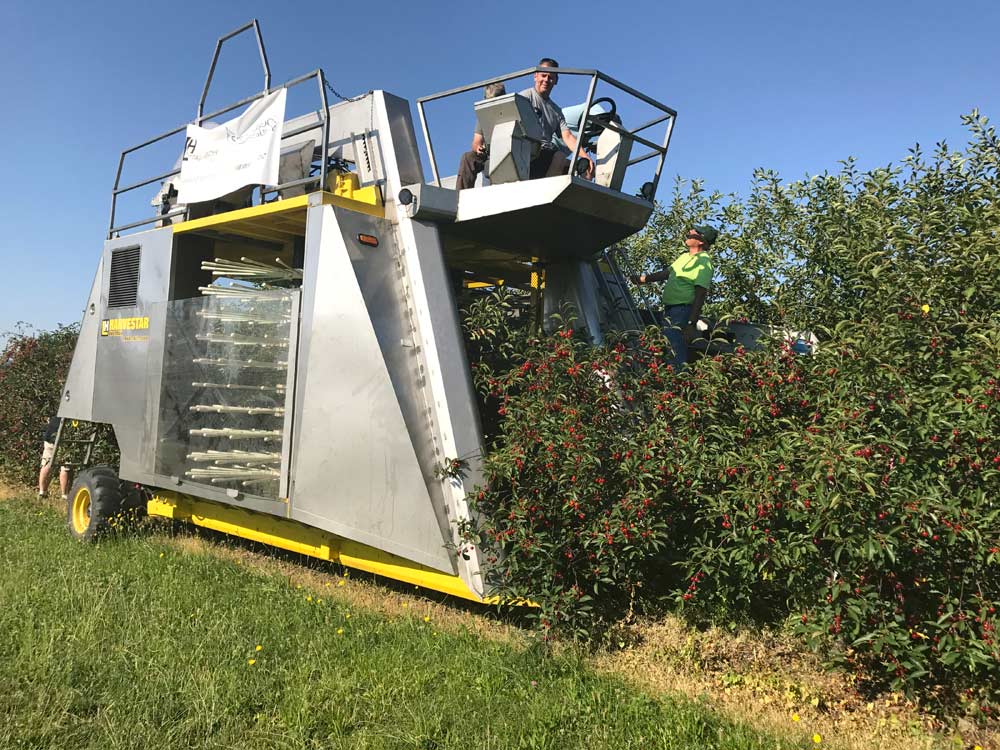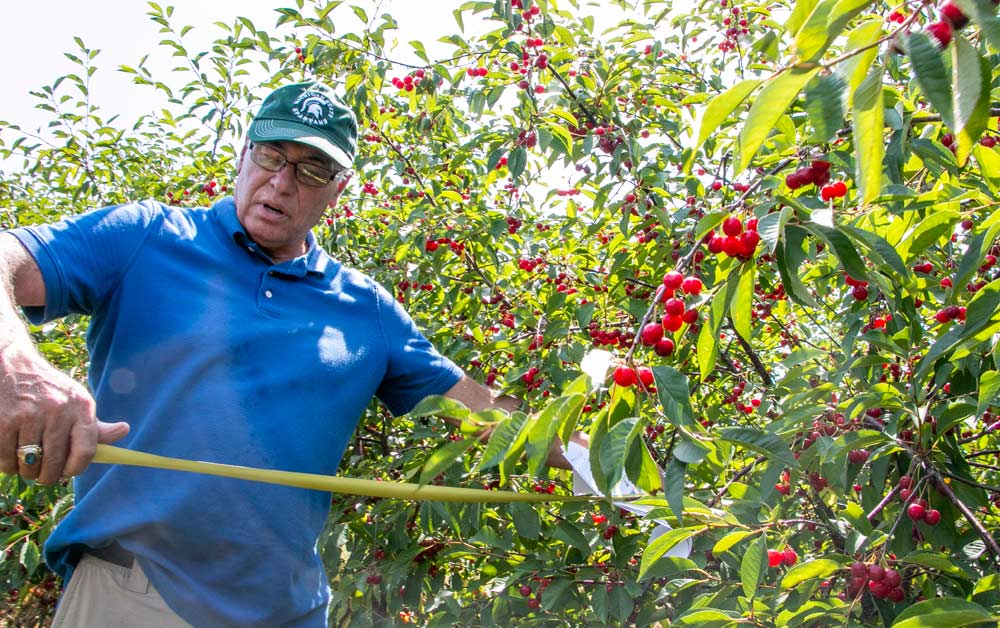
An over-the-row tart cherry harvester works Michigan State University high-density trial blocks in July 2017 in Traverse City. The machine harvested 10 tons per acre, twice the traditional average, from these seventh-leaf Montmorency trees on MSU dwarfing roostocks. (Courtesy Todd Einhorn/MSU)
The quest for high-density tart cherries picked by an over-the-row harvester marches on as researchers in Michigan and Utah continue to look for the best rootstocks, pruning and training to make it happen.
So far, so good, they said.
For one thing, the industry now has a machine specific to tart cherries — and it really moves. Standing 11 feet tall and using rotary tines much like a blueberry harvester, the machine gathered 20,000 pounds per acre in the summer of 2017 in Traverse City, Michigan, trials, more than twice the tart cherry average using trunk shakers. And those trees were only in their seventh leaf, still shy of full maturity.
“I was exceedingly pleased,” said Ron Perry, a retired Michigan State University horticulturist who had been leading some of the work. He has since passed it off to Todd Einhorn, also an MSU horticulturist.
The picker, made by Littau Harvester in Stayton, Oregon, straddled Montmorency trees on Mahaleb rootstocks as high as 13 feet tall, simply bending the willowy top branches into its towers, Perry said. “It certainly can handle a pretty large tree.”
That means some canopy management may allow growers to use the equipment on relatively tall Montmorency trees on Mahaleb rootstocks, the industry standards, he said.
However, the industry is still headed toward new roots.
“Dwarfing rootstocks will be central to sustainable high-density tart cherry systems,” Einhorn said.
He and Perry are evaluating the Gisela series of precocious and dwarfing rootstocks — commonly used in sweet cherries — as well as five MSU dwarfing roots recently developed by Amy Iezzoni, an MSU cherry breeder (See “Small trees, big cherries,” Good Fruit Grower, May 15, 2018 issue). In the 2017 trials, Iezzoni’s rootstocks produced trees that yielded similarly to those 20,000-pounds-per-acre Mahalebs but with only half the canopy volume.
Quest for high-density
Thus, the machinery is only one part of the equation, said Phil Korson, president of the Cherry Marketing Institute in Michigan, which is helping fund some of MSU’s work. The cherry industry has been searching for years for a way to grow and harvest tart cherries in high-density blocks to boost profitability.
Over-the-row harvesting may replace traditional trunk shakers, which create wounds that let in diseases and pests and shorten the life of the trees. The shakers also can’t be used on trees younger than about 6 years old. Meanwhile, over-the-row harvesting can start much earlier, possibly as early as the second leaf, Korson said. “Those extra four years of income make all the difference.”
The industry’s current state of low prices and holdover inventory dating back to a bumper 2016 crop don’t affect the research, which is a long-term investment, he said. In fact, the current problems make the work even more important. “These are the kind of systems that have high ROIs (returns on investment) and keep growers profitable when prices go down,” he said.
Littau is entering its fourth season with the $360,000 machine, claiming it can harvest 300,000 pounds in 10 hours — 2.5 times what shakers could collect. “We’re basically picking at 2 miles an hour,” said Frank Brown, sales and purchasing manager.
One harvester is staying in Michigan for MSU trials and for a lease by a Southwest Michigan grower. Another belongs to an Eastern Washington grower near Royal City. Meanwhile, the company is working on a third and has tested it on an olive farm near Bakersfield, California.
Chris Oxley, the Lawton, Michigan, grower who leases the machine, agrees the concept of rotary tine harvesting causes less damage to fruit and trees than shaking. “We’ve proven that over and over again that works,” he said.
However, converting to high-density orchards is going to require better site location than in the past, he said. Too many orchards sit low and are vulnerable to frost. (Perry argued that problem never stopped the growth of high-density trees that dominate the apple industry today.)
Oxley will use the machine this year to harvest about 80 acres of tart cherries. Some of them sit in an orchard converted from traditional 19-foot spacing to roughly 6 feet after a 2010 hailstorm. He also has planted new acreage with Perry’s recommended 5-by-13 spacing.
Oxley has another 200 acres he will shake conventionally, and just last spring he planted three new rootstocks.
More experiments in Utah
Utah State University also has test plantings throughout the state, both on university grounds and in commercial blocks. Brent Black, extension fruit specialist, leads trials comparing different rootstocks, training systems and in-row spacing dating back to 2010. One of his graduate students is now pitching her thesis about pruning and training strategies to research publications.
So far, they have used a modified over-the-row blueberry picker but have not reached the same high yields as MSU, Black said. His yields using Gisela rootstocks on tight spacing have typically been 9,000 to 14,000 pounds per acre, approaching the statewide average.
Growers have collaborated by putting in some test blocks but no commercial plantings yet.
“Growers are interested enough to host small test plantings, but nothing beyond this,” he said. “Unless we can find a way to significantly boost our yields … then it likely won’t be commercially viable for us.”
Differences in training systems or climate might explain the difference in yields between Michigan and Utah, though researchers in either state aren’t sure. Black had been using spindle trees in his trials but plans to add hedging as a canopy management technique in the future.

Retired Michigan State University horticulturist Ron Perry measures tree canopies in July 2017 at the university’s Traverse City trial blocks. Perry and fellow researchers at MSU and Utah State University are exploring ways to grow high-density tart cherry orchards picked with an over-the-row harvester to boost yields and lengthen tree life. (Ross Courtney/Good Fruit Grower)
Back in Michigan, Perry began MSU’s project 10 years ago, planting new trees in 2011 with grant funding and using a modified blueberry harvester, similar to Black’s. In the 13 trial rows are five different varieties on five rootstocks with four different pruning methods — root pruning, summer hedging, winter hedging and control.
They are planted 670 trees per acre at 5-foot spacing with 13 feet between rows. Traditional tart cherry orchards use 18-by-20 spacing.
Michigan growers are interested in the denser trees, so Einhorn is leading 1-acre trials, planted in 2017, at several farms to evaluate the different rootstocks and management techniques.
Perry also suspects the tine harvester can pull cherries that wouldn’t fall on a shaker without the use of Ethephon, a chemical currently sprayed on most tart cherries to weaken their stem-to-fruit connection and make them mature more uniformly.
“We think you can bypass the use of Ethephon,” he said. •
—by Ross Courtney






Leave A Comment